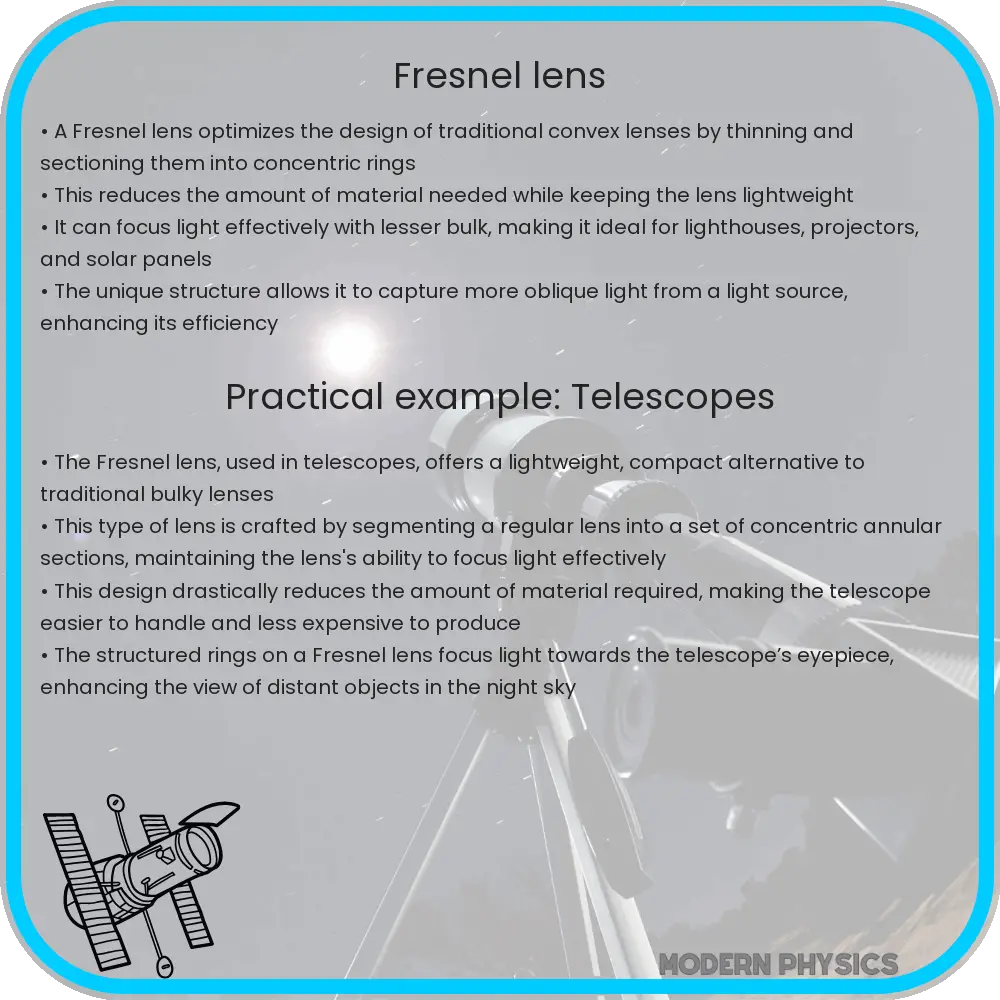Explore the innovation of Fresnel lenses, from lighthouse beacons to modern technology, highlighting their efficiency, design, and diverse applications.

Understanding Fresnel Lenses: The Pinnacle of Optical Efficiency and Compact Design
The Fresnel lens, a marvel of optical engineering, is renowned for its unique ability to capture and focus light with remarkable precision and efficiency. Developed in the early 19th century by French physicist Augustin-Jean Fresnel, these lenses have revolutionized various fields, ranging from lighthouse illumination to modern applications in solar power and photography. The key to their widespread success lies in their ingenious design, which merges the principles of optical precision with compactness.
Principles of Fresnel Lens Design
Fresnel lenses distinguish themselves through their innovative structure. Unlike traditional convex lenses, which are thick and bulky due to their curved shape, Fresnel lenses are crafted by segmenting the lens into a series of concentric, annular sections known as ‘Fresnel zones.’ These zones are then flattened out, substantially reducing the thickness and weight of the lens while preserving its optical properties. This ingenious design means that a Fresnel lens can be large in diameter yet remain incredibly thin and lightweight, making them ideal for applications where size and weight are critical considerations.
Optical Efficiency and Precision
The optical efficiency of Fresnel lenses is another key aspect of their appeal. By design, these lenses can capture and redirect light more effectively than traditional lenses. This is particularly beneficial in applications like lighthouses, where the ability to cast light over long distances is essential. The precision of Fresnel lenses is equally impressive. Their unique structure allows them to focus light with a high degree of accuracy, making them highly effective in applications ranging from projector systems to solar concentrators.
Modern Applications of Fresnel Lenses
In the modern era, the versatility of Fresnel lenses has led to their adoption in a diverse array of applications. They are extensively used in solar power systems, where their ability to concentrate sunlight onto a small area dramatically increases the efficiency of solar panels. In photography and film-making, Fresnel lenses are employed in lighting equipment to provide focused and adjustable illumination. Additionally, their compact nature makes them ideal for portable optical devices, such as virtual reality headsets and magnifying glasses.
Understanding the science behind Fresnel lenses enhances appreciation for their role in advancing technology. Their intricate design, which allows for both optical precision and compactness, is rooted in the principles of wave optics. By segmenting a conventional lens into smaller, flatter sections, Fresnel lenses effectively reduce the amount of material required without compromising their ability to refract and focus light. This not only makes them lighter and more manageable but also significantly more cost-effective to produce, especially when large lenses are required.
Advancements in Fresnel Lens Technology
The evolution of Fresnel lens technology continues to open new avenues in optical engineering. Recent advancements have focused on enhancing the material quality and refining the manufacturing processes. Materials such as acrylics and polycarbonates are now commonly used, offering greater durability and resistance to environmental factors compared to traditional glass. Moreover, modern manufacturing techniques, including precision molding and laser cutting, have enabled the production of Fresnel lenses with increasingly intricate and accurate profiles. This has further improved their optical performance and expanded their application scope.
Environmental Impact and Sustainability
Another significant aspect of Fresnel lenses is their contribution to environmental sustainability. In solar energy systems, Fresnel lenses are used to concentrate sunlight onto photovoltaic cells, substantially reducing the amount of semiconductor material needed. This not only lowers the cost of solar panels but also minimizes the environmental impact associated with the production of photovoltaic materials. Additionally, the compact and lightweight nature of Fresnel lenses reduces the carbon footprint associated with their transport and installation.
Educational and Experimental Uses
Fresnel lenses also find application in educational and experimental settings. Their ability to demonstrate principles of light refraction and focus makes them excellent tools for teaching optics. They are used in classrooms and laboratories to illustrate fundamental optical concepts and phenomena in a tangible and interactive manner. Their affordability and safety, especially when made from plastic materials, make them accessible and suitable for students of all ages.
Conclusion
In summary, Fresnel lenses represent a remarkable fusion of optical precision, efficiency, and compact design. Their evolution from lighthouse beacons to key components in modern technological applications underscores their versatility and enduring relevance. Advances in materials and manufacturing techniques continue to expand their capabilities, while their role in promoting environmental sustainability marks them as a significant contributor to green technology. Whether in the realm of solar energy, photography, virtual reality, or education, Fresnel lenses continue to shine a light on the future of optical innovation, demonstrating the enduring power of a great idea conceived nearly two centuries ago.
Is this conversation helpful so far?
